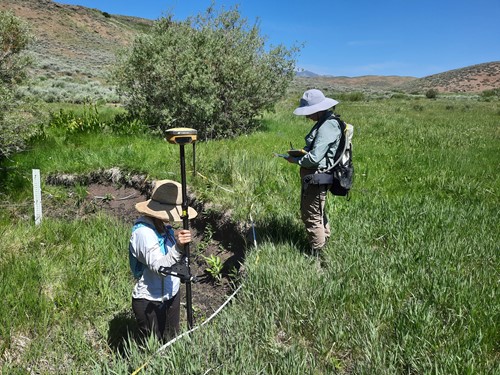U of I researching artificial beaver dams as stream restoration tool
By John O’Connell
University of Idaho
 MOSCOW, Idaho – University of Idaho researchers are testing artificial beaver dams as a tool to restore degraded stream systems, thereby improving riparian habitat and bolstering the late-season water supply.
MOSCOW, Idaho – University of Idaho researchers are testing artificial beaver dams as a tool to restore degraded stream systems, thereby improving riparian habitat and bolstering the late-season water supply.
Known as beaver dam analogs, these structures comprise the same materials beavers use in nature, including willow boughs, sediment and stone.
They cause water to pool and spill beyond the banks. The spillage supports marshland vegetation before seeping into the groundwater and re-emerging later in the season downstream.
Beaver dam analogs provide an option to restore habitat where resources are insufficient to support beavers or where beavers would pose a nuisance.
A team of researchers with U of I’s College of Agricultural and Life Sciences (CALS) and College of Natural Resources (CNR) is entering the final year of a three-year study of the concept, funded with a $75,000 USDA Natural Resources Conservation Service grant.
The research is being conducted in an intermittent stream, Guy Creek, within the university’s Rinker Rock Creek Ranch in central Idaho’s Wood River Valley.
From CNR, the research team includes Jason Karl, Harold F. and Ruth M. Heady endowed chair of Rangeland Ecology; Charles Goebel, head of the Department of Forest, Rangeland and Fire Sciences; and Eric Winford, who is spearheading the project as his dissertation for a doctorate in natural resources.
CALS team members include Melinda Ellison, an assistant professor and Extension specialist focused on the effects of raising livestock on wildlife and range; Laurel Lynch, assistant professor with the Department of Soil and Water Systems; and two of Lynch’s graduate students – Ellen Incelli, a graduate student studying environmental science, and Heather Neace, a graduate student studying water resources science and management.
“It really is bringing together CALS with CNR to ask some of these important social and ecological questions,” Winford said. “Across the West we can restore some of the function beavers were maintaining in these systems by mimicking their activity.”
At the project’s start, Guy Creek flowed through a deep channel disconnected from riparian areas. Riparian vegetation can be essential for livestock, providing a verdant source of late-season forage.
In July 2020, a group of recent high school graduates with the Idaho Conservation Corps spent a week helping the research team build 65 beaver dam analogs within three meadows.
The team has been using drones to evaluate gradual changes in the channel. They’ve noticed pools and riffles are forming and sediment is accumulating behind the structures, and they expect to eventually see gains in groundwater levels and improvements in natural processes such as nutrient cycling.
They anticipate their stream gages and groundwater monitoring will evidence that beaver dam analogs build up groundwater and hold water until it’s needed without curbing flows to downstream users.
The Idaho Department of Water Resources requires anyone who installs a beaver dam analog to obtain a permit and is interested in the research.
“In the lower two meadows we’ve been able to collect water samples later in the season from more pools than the year before,” Lynch said. “It’s too early to say definitively that water levels are increasing, but it does seem anecdotally we’re pushing the system in that direction.”
Lynch and her graduate students are also evaluating how riparian restoration influences water quality, soil carbon, microbial ecology and soil macroinvertebrate density.
The team plans to host field days and workshops at Rinker Rock Creek Ranch for public land managers and private landowners to highlight the beaver dam analogs, as well as how to make and maintain them.
Several federal agencies offer funding for improving wildlife habitat that could be used for building them.
“There are potentially hundreds of miles of these meadows throughout the state where these could be applied,” Winford said.
Still can't find what you are looking for? Find by topic:
- Achievement Award (YF&R)
- Actions Alerts
- Advocacy
- Ag Ambassadors
- American Farm Bureau
- American Farm Bureau Policy Book
- Archive Photos
- Articles
- Board of Directors
- Calendar - State/District
- Calendar - County
- Capitol Reflections
- Collegiate Chapters
- Committee Application Form
- Commodities
- Convention Annual
- County Presidents & Board Information
- County Resource Page
- Delegate Form
- Discount Programs
- Discussion Meet
- Discussion Meet - High School
- Education Programs
- Events
- Excellence Award (YF&R)
- Expense Voucher
- Flickr
- Gem State Producer
- High School Discussion Meet
- High School Speech Contest
- Hope in Idaho Ag
- House of Delegates Credentials Form
- IFBF Board of Directors
- IFBF Policy Book
- IFBF Staff
- Insurance
- Legislative Action Program
- Legislative Issues
- Library
- MAC Trailer
- Magazines
- Map My Benefits
- Member Benefits
- Member Discount
- Membership Application
- Mission Statement
- Moving Agriculture to the Classroom
- Newsletter Sign up
- News Releases
- News Room
- Open Range Law
